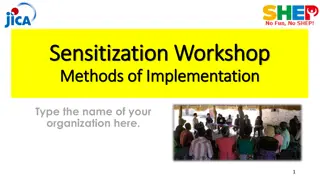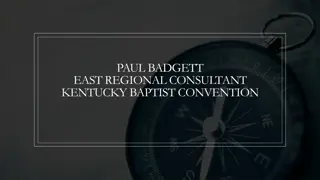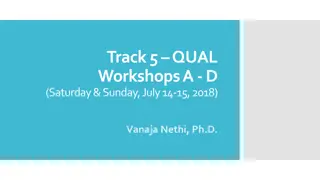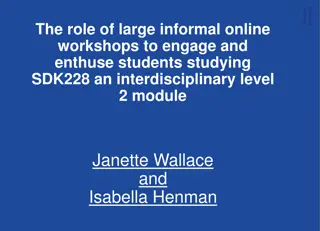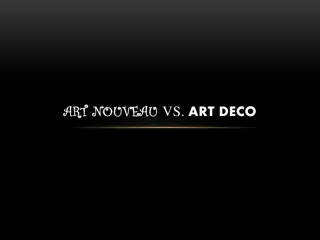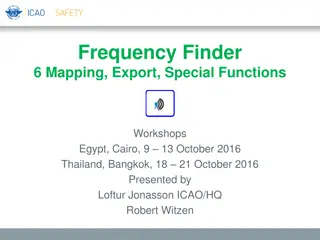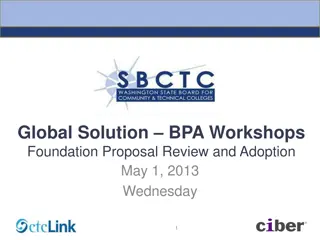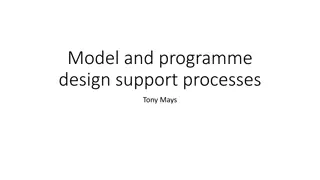The Art and Science of Collaboration: Insights and Workshops
Explore the essence of collaboration in organizations, delving into its definition, importance, workshop focus, and research insights. Discover why collaboration is crucial for success and how to achieve better results through effective teamwork.
Download Presentation

Please find below an Image/Link to download the presentation.
The content on the website is provided AS IS for your information and personal use only. It may not be sold, licensed, or shared on other websites without obtaining consent from the author.If you encounter any issues during the download, it is possible that the publisher has removed the file from their server.
You are allowed to download the files provided on this website for personal or commercial use, subject to the condition that they are used lawfully. All files are the property of their respective owners.
The content on the website is provided AS IS for your information and personal use only. It may not be sold, licensed, or shared on other websites without obtaining consent from the author.
E N D
Presentation Transcript
The Art and Science of Collaboration Thank You for Being Our Guinea Pigs
Thinking Behind The Art and Science of Collaboration Very few of us have been trained in collaboration Professional development is expensive and difficult to secure We have been learning by doing What have we been doing right? What have we been doing wrong? What trips us up and what can we do about it
What is Collaboration? Collaboration Noun (often followed by on, with, etc.) the act of working with another or others on a joint project something created by working jointly with another or others the act of cooperating as a traitor, esp with an enemy occupying one's own country Seriously?! I had no idea .
What the focus of this workshop will be This workshop will focus on collaboration within organizations Not on collaboration between organizations Not on collaborations within a department (Unit Collaboration) But on collaboration between departments (Cross Unit Collaboration) Cross unit collaboration tales place when people from different departments work together in cross-departmental teams on a common task or provide significant help to each other. It always involves people. They don t have to each help each other equally.
Insights into this Workshop Been undertaking research on how private sector and public sector have been advancing collaboration whatworks, what doesn t? Morton Hansen, Collaboration: How Leaders Avoid the Traps, Build Common Ground and Reep Big Results Taking our PD in this area and trying to share it There is a wealth of experience within this network Want to be able to capture the experiences and lessons learned within the network
Why Bother with Collaboration? In complex organizational activities, effective collaboration is often a necessary requirement for success However, collaboration is not the goal The goal is to achieve better results Great project performance Better decisions Lower costs Better outputs and outcomes Solving problems people care about Collaboration is a means to an end ..and that end is great performance. This means that often it may be better not to collaborate because there is simply no compelling reason to do so. To be disciplined about collaboration is to know when not to collaborate.
Personal Collaboration Facilitating Factors Emotional Regulation Relationship Building Leadership Altruism Delineation Goal Setting Engagement Familiarity
What we can Learn from the Private Sector Structured orientations towards networking from the onset and continuing it on an ongoing basis Mentorship structures Fostering a culture of openness and diversity of views Thinking differently is encouraged Judging and criticizing people for thinking differently isn't Competition within the organization should be discouraged
Challenges of Collaboration Collaboration in Hostile Territory Collaboration fails in environments that are designed for the opposite practice competition and independence. The trap is to believe that competing units can collaborate and launch ambitious projects in such unreceptive environments. Misdiagnosing the problem: Misdiagnosing the reason people don t collaborate or why collaboration isn t working. Implementing the wrong solution The wrong solution trap often accompanies the misdiagnosing solution. Different barriers to collaboration require different solutions. All these traps lead to bad collaboration collaboration characterized by high friction and a poor focus on results.
The Down Side of Collaboration Good collaboration amplifies strengths BUT poor collaboration is worse than no collaboration at all Consumes increasing amounts of time with not a lot of results being achieved Collaboration should not be undertaken for its own sake, it is meant and needs to be set up to achieve a result and monitor progress towards that result. Overshooting the Potential Value There is the trap of overshooting the potential of collaboration. It s easy to get carried away, believing there is huge synergy benefits to be gained by collaborating across departments. Underestimating the Costs of Collaboration Not accounting for the challenges associated with collaboration and assuming collaboration will go smoothly and without barriers. Don t underestimate the challenges and the costs associated with working across an organization and resolving conflict.
The Collaboration Solution Disciplined Collaboration the leadership practice of properly assessing when to collaborate (and when not to) Instilling in people both the willingness and the ability to collaborate when required.
Modern Management and Collaboration Collaboration rarely occurs naturally because leaders often unintentionally erect barriers that block people from collaborating many people have a natural tendency to collaborate, but they are not left to their own devices. And the culprit is modern management. Managers and management thinkers celebrate decentralization which works like this: you delegate responsibilities for operations, products service areas to a group of managers. The clearer the lines of responsibility the better. You then develop objectives and metrics for each manager so that he or she knows what to achieve for a given time period. To improve the chances for success you give the managers considerable freedom they run their own unit. You then hold them accountable for their results and put in place incentives to motivate them. This is the essence of modern management A decentralized system with clear lines of communication and a great deal of accountability and rewards for performance. It delivers very good performance up to a point. The problem is that each manager becomes increasingly independent and tries to maximize his or her own unit. After all that is how their job is defined. Very few job descriptions take into account synergies or misalignments between different departments objectives. The solution however is not to dismantle the decentralized system and go for the opposite extreme centralization- where a few people at the top decide and filter information. That is throwing the baby out with the bath water. After all the decentralized approach produces benefits. Discipline collaboration requires the organization to be decentralized and coordinated.
Inter-Departmental Collaboration Path Step 1: Evaluate Opportunities to Collaborate: Identify when you need to collaborate, for what outcome and why you can t go it alone, and who you need to collaborate with Once you have answered yes to the question on whether there is an upside to collaboration the next question is: What are the barriers blocking people from collaboration well? Step 2: Spot Barriers to Collaboration People do not collaborate well for various reasons. Lack of motivation. People are not willing. Why aren t they not willing? Other barriers have to do with ability. People can t do it easily. What would make collaboration easier for them? The not invented here barrier (people are unwilling to reach out to others or listen to others) The hoarding barrier (people are unwilling to provide help) The search barrier (people are not able to find the help they are looking for) The Transfer barrier (people are not able to work with people they don t know well. All four barriers need to be low before effective collaboration can really take place.
Inter-Departmental Collaboration Path Step 3: Tailor solutions to tear down the barriers Different barriers require different solutions Ability barriers mean that leaders need to pull levers that enable motivated people to collaborate. Unification lever crafting common goals, articulating a strong value of cross departmental teamwork and talk the talk of collaboration to send strong signals that lift peoples sights beyond narrow interests and toward a common goal. People lever: cultivate a certain type of management. Get the right people to collaborate on the right projects. T shaped management people simultaneously concentrate on the performance of their unit and across boundaries. They are willing and able to collaborate when needed, but disciplined enough to say no when it is wrong or not necessary or working. Network lever: build nimble inter-personal networks across the company so that employees are more able to collaborate. Collaboration works more through interpersonal networks and less through formal hierarchies When people spend more time networking than getting work done collaboration destroys results. Cultivating collaboration in others and cultivating collaboration in individual leaders
Collaboration Barrier # 1: The Not Invented Here Barrier Arises when people are not willing to reach beyond their own units to get input and collaborate. Why don t people reach out and seek help? Insular culture (communication mainly inside the group) Status gap (don t want to cross status lines) Self reliance (should fix your own problems) Fear (do not want to reveal problems) People who work together can develop an insular culture. They spend time with each other to the exclusion of others, they restrict the influx of new viewpoints and reinforce their already help points of view. Status gap If individuals think they have higher status than others they will not reach out to collaborate with those lower down the status chain folks. Status gaps run both ways high status people do not want to sully their image of themselves and low status people do not want high status people making them feel bad about their circumstances. Both attitude create a barrier to collaboration. Self Reliance People can have a deep seated belief that people need to solve their problems by themselves and asking for help is a sign of weakness of incompetence. You can see how that would stop people from reaching out to others for help. Fear of revealing shortcomings people often fear exposing their weaknesses to others especially to their peers and even experts.
Collaboration Barrier # 2: The Hoarding Barrier Some people deliberately do not want to share with others; their withhold their help, information time and effort. Competition undermines peoples willingness to collaborate. Narrow incentives rewards for own goals only No time to help others The emphasis on performance management over the past decade has created a time famine at work. People feel pressured to perform based on metric s which likely do not include metrics for how often they work across division or how often they help others in other divisions. Collaboration can just be seem as a burden without any benefit to them under these circumstances. Fear of loss of power if sharing information Knowledge is power. Implying that that person is more powerful the more they know and the less others know. So why share that information? If people feel they will becomes less powerful or more redundant you can see why they may not want to collaborate or share the information they have. All leads to hoarding where people are unwilling to help and share what they know.
Collaboration Barrier # 3: The Search Barrier Unlike the first two barriers where people are unwilling to collaborate the search barrier concerns the inability to find information and people in a company. Why the search barrier happens Organization size big organizations face search challenges Physical distance distance makes search difficult Information overload too much information worsens search Poverty of network lack of links between departments undermines search
Collaboration Barrier # 4: The Transfer Barrier People run into problems in transferring expertise know how and technologies when people from the different units do not know how to work together. This transfer problem is not based on motivation but rather on abilities. People can be highly motivated to work together but they can find it difficult to do so. No common frame People who do not know each other have no common frame and understanding of each others working habits subtle ways of articulating something a liking for each other and an appreciation of each other s moods or styles. This may not seem like a big deal but it is. This common frame can play a big role in helping to address a number of barriers or at least the willingness to try. Weak ties People find it hard to transfer knowledge when they don t know each other very well. They need strong ties relationships where people talk and have a close working relationship. Weak ties create havoc when people need to transfer tacit knowledge.
From Barriers to Solutions To build this model leaders need to detect the barriers to collaboration and overcome them without reducing the benefits of a decentralized approach. The first step in overcoming barriers is to accurately assess which barriers you are dealing with. The second step is to tailor management solutions to each barrier. Notice that the first two barriers (not invented here and hoarding) concern motivational issues. The two barriers exist because people are not willing to collaborate. This means that management solutions must motivate people to collaborate. Unify people: craft a unifying goal, state a core value of teamwork and use the leadership pulpit to signal collaboration Cultivate T shaped management: Use recruitment, promotion, firing and rewards to cultivate collaboration. These solutions help select the right people who are motivated to collaborate in the first place and helps to change the attitude of others. Build nimble networks: encourage formation of the right kinds of cross unit personal relationships to help search and reduce transfer problems.
Barrier Interventions Leaders can easily pit groups in their organization against each other and induce competition. Leaders need to learn how easily internal rivalry can take hold and undermine collaboration. Leaders also have the power to unite separate groups by the actions they take. Leadership is ultimately about uniting and empowering people. Unification mechanisms allow a leader to translate the lofty aspiration of unity into concrete measures 1. Create a unifying goal 2. Incite a common value of team work
The Power of a Unifying Goal Criteria # 1: The goal must create a common fate A unifying goal has power only if all relevant groups need to pull together to make it a reality. The greatest benefit of a common fate goal is that it elevates the aspirations of people to something bigger than parochial goals. Criteria #2: the goal must be simple and concrete It needs to be simple and concrete enough that any person can understand it and know what success looks like without ambiguity. US world leadership preeminence in space versus land a man on the moon.
The Power of a Unifying Goal Criteria # 3: the goal must stir passion Powerful unifying goals stir passion and inspire. They appeal to peoples hearts and not only their minds. Criteria # 4: The goal must put competing on the outside Few things unite people better than having a common enemy. Leaders who practice disciplined collaboration get this straight: collaboration does not replace competition. The target of the competition should be outside the organization not inside.
Teamwork Values Create a Core value of teamwork On a board write out feedback from people on what their core values are Are there values that conflict with each other? There can often be very different people in the room. Some more team oriented some more individual oriented. These opposing beliefs can come out in full force and clash with each other big time. Is one more right than the other? We can be successful by holding onto the different values can we not? To create disciplined collaboration both need to be valued. It is the combination of team work and individual ownership that leads to disciplined collaboration. Leaders need to give voice to the value of team work. They need to create it in a value statement . They need to write it up in a list of required leadership competencies. But as they preach teamwork they need to be aware of three sins.
Collaboration Sins Sin # 1: Small teamwork kills When managers start instilling teamwork in their own units that leads to team work but not necessarily organization collaboration To address this danger and tendency leaders need to preach that team work means teaming across the company. Sin # 2: Everybody do teamwork now (except those at the top) When leaders give a sermon about the value of teamwork and then ignore it themselves . Well everyone hates a hypocrite. If the top executives aren t working well together the departments will have a more challenging time working together. Sin # 3: Team work becomes the point of it all People judgements about when to in team and when not to get corrupted by a specific norm leading them one direction or another. Remember the point isn t teamwork or collaboration it is better results. The language and behaviors a leader chooses matters a great deal in shaping behavior.
Lever # 2: Cultivate TShaped Management Leaders cannot build a collaborative company with lone starts. Sure in companies where individual performance reigns and where company performance is just the sum of individual performers leaders benefit significantly from lone stars. If leaders want achievers who work across the organization lone stars will make the task much more challenging. T-Shaped management people simultaneously deliver on their individual performance (the vertical part of the T) and deliver results by collaborating across the organizations (the horizontal part of the T). They stand out from the lone stars and the butterfly s because they perform two things well and not just one. T-Shaped managers also differ from butterflies people who work well across the organizations, but fail to do well in their won jobs. To cultivate T-Shaped management leaders need to implement two sided performance management They need to regard people for individual results and for contribution to other units.
Performance Structures that Hurt Collaboration Bad incentive # 1 : Unit performance only Bad incentive # 2: Corporate wide performance Link performance evaluation to collaboration It is difficult to make personal changes when coworkers have come to expect old behaviors. Need to also work with co workers to help expect and reinforce that behavior in the person. Concentrate on changing people behaviors over their attitudes Coaching: person receives coaching to better enable them to build their ability to function on both parts of the T Peer pressure and support creates the expectation that others are expecting them to improve upon the side of the T they are weak in.
Networking Bridges Who are they? Someone by the virtue of their network can connect the many divisions of a company by putting people in contact with one another. Myths about networks networking is always a good thing. You cant spend time interacting with others at the expense of completing you own work. Diversity of networks is particularly important Networking is an art but there is a science to it too. Good networkers can be found anywhere. They can be introverts, extroverts, shy, gregarious, insecure or cocky. Network maps can show strong links and gaps what networks look like and how to improve them.
What Makes a Difference in Networking? What matters in networking is diversity. Its more important to know different people in different networks. Build network diversity. Contacts with different cliques of people (who don t talk across cliques) Contacts with different technologies Contacts with different types of expertise Contacts of different ages Contacts with different experience (newby as well as older more established) Different gender, nationality and ethnicity What additional diversity does this new contact bring me? Disciplined collaboration means adding contacts that bring more diversity to you network. Better to have a lot of weak ties rather than strong ties as strong ties require more time and effort and strong ties often don t bring the diversity as we tend to form strong ties with those very similar to us.
Network rule: Use Bridges Not Familiar Faces People need to build bridges in their organizational network. Bridges are uniquely placed by virtue of their networks to help people s search. People use them for who they know not what they know. Leaders who build powerful organization wide networks ensures that there are enough people performing the bridging role. Having only a few bridges across departments indicates a network vulnerable to collapse. Job rotation across units. Like public health and planning.
Network Rule: Swarm the Target: Do Not Go it Alone. Invoke common links. Mention common contacts. Get common contacts to work on your behalf, introductions. Network Rule: When it comes to complicated/expert knowledge Switch to strong ties - do not rely on weak ones. Molotov cocktail = weak ties X complicated knowledge Easier transfer = strong ties X complicated knowledge Getting people to know each other on short notice sounds difficult but it can often be easier than thought. Managers must act forcefully when they see a situation involving weak ties across units team exercises to build a one-team culture.
Summary: Nimble network = identify opportunities X capture value Build outward Diverse Many weak ties Many bridges Swarming targets Switching to strong ties
Cultivating a Collaborative Leadership Style Redefining Success: From narrow agendas to bigger goals Collaborative leaders redefine success and focus on goals bigger than their own narrow agendas. They seek common ground, look for pragmatic solutions and compromise. Involving others: from autocratic to inclusive decision making Collaborative leaders involve others in decision making and exhibit and open mind to alternatives, divergent views, dialogue and working with others. Collaborative leaders hold themselves accountable and they demand accountability from others. Putting personal Goals and Interests second The collaborative leader has the capacity to subordinate his or her own goals to the larger goals of the institution. In most cases there is no conflict of interest between personal interests and the organizational interests. But sometimes self interest and the interests of the enterprise diverge. Collaborative leaders follow a rule in these situations by prioritizing the bigger goals.
Collaborative Leadership Behaviors/Styles Getting others to transcend their Own agendas and support inclusive decision making Each participant functions as a skeptical generalist focusing on the problem rather than approaching it from his departments standpoint. Use informal settings with no formal agenda and protocol Sub groups the team would be broken into that would work on alternatives and then reconvene. Follow leaderless sessions so people aren t afraid to speak against the leader or person of high status. Encourages everyone to speak as equals. Role playing where people play different pros and cons of approaches. Openness to people: inclusive leaders invite a fairly diverse group of people into their decision making process. Openness to Alternatives: inclusive leaders give serious consideration to different views. They listen well they seek to understand what others think and why. This requires leaders to be empathetic to put themselves in the shoes of others and see things from their perspective. Being this way is rare in leaders. Openness to debate: inclusive leaders encourage debate and make it safe to voice opinions. People need to feel safe to speak up without fear of retribution. Leaders who praise dissent and alternative suggestions even if they are not followed help create this safety. Collaborative leaders who master this inclusive style make better decisions and get better buy-in. it ensures that alternative views are considered and that flaws in thinking are exposed.
Collaboration and Accountability When everyone is involved who is held accountable? The bystander and loafer effect is a vital problem in collaborative work. When people can slack off or hide they often do. If individual effort is not tracked and only team effort is tracked. The antidote to this malaise is the third behavior found in collaborative leadership: a high degree individual accountability. Collaborative leaders hold themselves accountable even though collaborative work often leads to a diffusion of responsibility. Collaborative leaders who hold themselves and others accountable engage in a few key practices. They spell out what they are accountable for which targets what kind of actions/jobs You can t hold yourself and others accountable if you don t know what you are accountable for. They then accept responsibility for mistakes and poor performance no matter the circumstances and whether or not others mess up the collaborative effort.
Personal Barriers Hunger for power: leaders who seek power, who want others to depend on them, do less well in moving beyond their narrow agendas and redefining success as bigger goals. Arrogance: the attitude of I know best. Defensive attitude: less likely to want to take accountability and they are less inclusive they think opening up to others is admitting they are wrong. Fear. Fear leads to the tendency to stick to ones own narrow agenda rather than a focus on bigger goals. Big Egos: this seems to not have as strong an effect on collaborative behaviors as one would think
Redefining Success Being Inclusive Being Accountable Power Hungry Biggest Negative Negative Small Negative Arrogance Negative Biggest Negative No Effect Defensiveness Big Negative Big Negative Biggest Negative Fear Small Negative Small Negative No Effect Ego Small Negative Small Negative No Effect
Where to go next Will be sending you all out a draft primer providing more information on each of these slides Sending out exercises to help apply this information to your circumstances Gathering input on barriers that you think are most likely to thwart your collaboration efforts and results Gathering input on the interventions you have tried to address these barriers Your experiences with those interventions Documenting the experience, expertise and lessons learned within this network Sharing it amongst the network and with others
What supports Would help you? Secondments how realistic are they? Maintaining collaboration how important is that? How to deal with staff turnover (structures to put in place right from the start) What are the main things you wish you understood better about the art and science of collaboration? Where would you like to see us go with this?
Thank You.. For participating For providing your input For agreeing to let us follow up with you? Have a great day and weekend.




